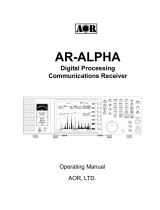
12
LOCK Press and hold this key for two seconds to activate the key lock function.
While activated, all front panel keys are disabled to prevent accidental misoperation of
the receiver. However, volume and squelch controls remain operative. To cancel, press
and hold this key again for two seconds.
MONI Press and hold this key to force open squelch. When frequency offset is activated,
pressing this key will display the offset frequency.
VFO In VFO mode, pressing this key will toggle between VFO-A and VFO-B.
Press and hold this key for two seconds to activate VFO search.
In other modes, press this key to return to VFO mode.
SRCH In program mode, press this key to copy the current frequency to VFO-Z and continue
receiving in VFO-Z.
SCAN Initiate scan in the memory read mode. While in scan mode, press this key to copy the
current frequency to VFO-Z and continue receiving in VFO-Z.
In other modes, press this key to return to VFO mode.
●
Start / Stop recording
[1] Figure ONE for the numeric input of frequencies, bank, channel numbers, etc.
[2] Figure TWO for the numeric input of frequencies, bank, channel numbers, etc.
[3] Figure THREE for the numeric input of frequencies, bank, channel numbers, etc.
[4] Figure FOUR for the numeric input of frequencies, bank, channel numbers, etc.
[5] Figure FIVE for the numeric input of frequencies, bank, channel numbers, etc.
[6] Figure SIX for the numeric input of frequencies, bank, channel numbers, etc.
[7] Figure SEVEN for the numeric input of frequencies, bank, channel numbers, etc.
[8] Figure EIGHT for the numeric input of frequencies, bank, channel numbers, etc.
[9] Figure NINE for the numeric input of frequencies, bank, channel numbers, etc.
[0] Figure ZERO for the numeric input of frequencies, bank, channel numbers, etc.
[ENT] Confirm entry in most menus.
In VFO mode, press this key to go to VFO-Z.
In VFO search or program search mode, press this key to transfer the detected
signal or stopped frequency to VFO-Z. The operation will be invalid while search is in
progress.
In memory read mode, press this key to transfer the current frequency to VFO-Z.
In memory scan mode, press this key to transfer the detected signal or
stopped frequency to VFO-Z. The operation will be invalid while scan is in progress.
[PASS] This key is used to pass (skip over) unwanted active frequencies in VFO search mode
and program search mode.
In memory search mode, this key is used to switch on/off pass channel.
[MODE] This key is to select the desired receive mode. Press this key to access the receive
mode menu. Rotate the dial knob to select the desired mode. To accept the selection,
press the [ENT] key.
Holding this key for two seconds will signal the receiver to go into digital auto mode.




















